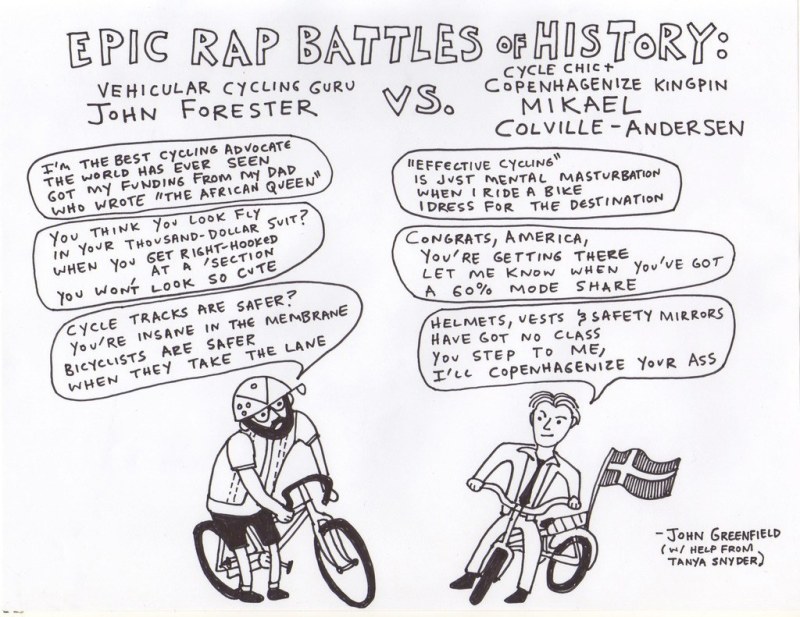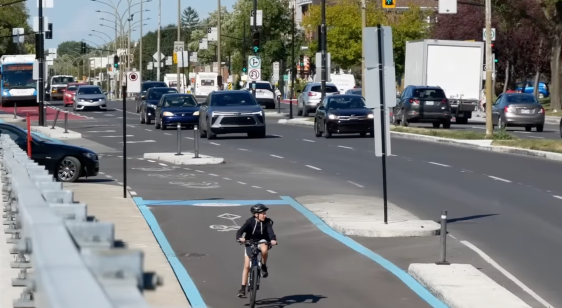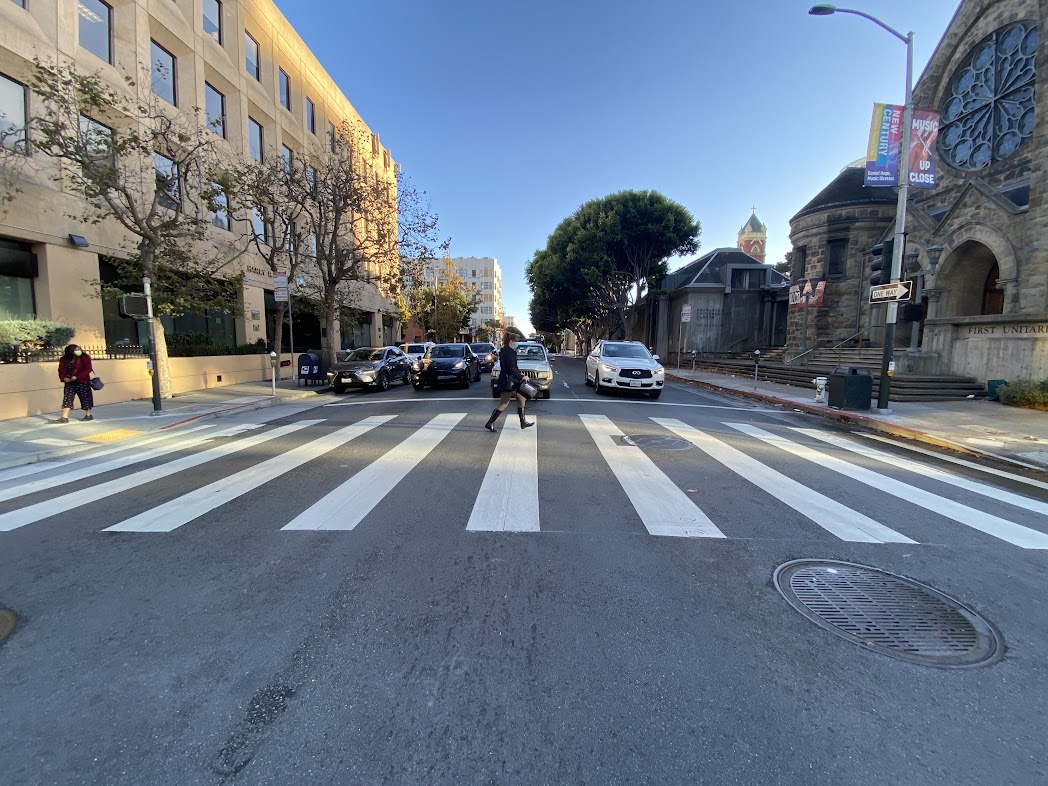“Effective Cycling” author John Forester, the grand old man of the anti-bike lane vehicular cycling movement, passed away recently at age 90. Read his obituary in Forbes magazine by Carlton Reid. Forester’s philosophy was at odds with Streetsblog’s goal of promoting street designs that allow anyone from age eight to 80 bike safely and comfortably. Below is our not-very-charitable look at his legacy, published last year. Still, I respect his tenacity in fighting for what he believed in, and the fact that he was still lucid and feisty up to the end of his life is a testament to the health benefits of cycling. So godspeed, Mr. Forester, may you ride on smooth pavement, with the wind at your back.
– John Greenfield, editor
A dinosaur still roams the earth: John Forester discusses his discredited anti-bikeway credo
Ever wonder why Chicago didn’t start installing physically protected bike lanes until 2011, while big cities in other countries have built protected lanes and sidepaths for many decades? If you were to single out one person to blame for why U.S. cities lag so far behind when it comes to safe bike infrastructure, that would be “Effective Cycling” author John Forester, known as the “father of vehicular cycling.”
As detailed in a paper published this spring by Toole Design Group (I heard about it from this Streetsblog USA article by Angie Schmitt), in the early 1970s many California municipalities installed bike lanes and side paths, and a few passed laws requiring cyclists to use bikeways instead of the street when available. This inspired Forester, a Palo Alto-based engineer whose hobby was bike racing, to write the book “Effective Cycling,” which argued that “Cyclists fare best when they act and are treated as drivers of vehicles.”
Forester conducted his own “experiments” to try to discredit the new California bikeways as being unsafe, making left turns off of sidewalk bike lanes at high speeds, and claimed that the results proved sidepaths are “about 1,000 times more dangerous than riding on the same roads.” While such tests were highly anecdotal, the fact that he was an engineer added an aura of credibility to his philosophical campaign against bike lanes, a crusade that became popular with other speedy cyclists who feared they would no longer be allowed to ride fast on streets.
Actual scientific studies and surveys during that era found that streets with bikeways saw fewer cyclist/motorist crashes than roadways where bike riders were expected to share a lane with drivers, and cyclists said they preferred having dedicated space. But Forester focused on the downsides of some bikeways — such as the possibility of dooring by motorists on on-street lanes, and the potential for conflicts with pedestrians on sidepaths — to make the false argument that bikeways always result in a net safety loss.
By the late the Seventies, Forester was head of the California Association of Bicycling Organizations, which helped write the 1978 bicycle planning guide for Caltrans, the state transportation department. The document stated that vehicular cycling — having cyclists pedal in the travel lane — should be the default, rather than building dedicated bike lanes for them. That in turn influenced the 1981 edition of the American Association of State Highway and Transportation Officials bicycle design guide, which didn’t see any major changes for many years.
It wasn’t until the early Nineties, when new studies confirmed that streets with bike lanes are safer than those without them, that there was a renewed interest in building bikeways in U.S. cities, which evolved into the American protected bike lane movement in the late 2000s, eventually led by the National Association of City Transportation Officials, a more progressive alternative to AASHTO, which produced its own Urban Bikeway Design Guide.
Recent research has confirmed that streets with protected bikeways are safer, and that most people prefer cycling in dedicated lanes, so Forester’s ideology has pretty much been relegated to the dustbin of history. But think of all the American lives lost since the 1970s due to bike crashes and sedentary lifestyles because of all the bike lanes that didn’t get built. That was in no small part due to Forester’s wrongheaded insistence that bikeways are unsafe.
In fairness, vehicular cycling, which typically involves riding in the middle of the travel lane at the speed of motor vehicle traffic, is a valid approach — if you’re a fit, relatively fearless person who can maintain a consistent speed of 15 mph or so. It’s also encouraging to see that, at age 89, Forester was still healthy and lucid enough to do an extensive interview recently with journalist Peter Flax about his legacy. In fact, he seems sharp as a (bike ride-ruining) tack, a testament to the old James E. Starrs quote, “Death may have no master, but the bicycle is, most emphatically, not its slave.”
Check out an excerpt from the 10,000-word-plus conversation, published here with permission from Flax, in which Forester clings to his widely-discredited credo that bike infrastructure makes cyclists less safe.
Peter Flax: So you just don’t feel like any of these kinds of changes make anyone safer? Your feeling is that beyond teaching people the ideas of Effective Cycling and putting yourself in the road in a way that maximizes your visibility and safety — that that is a better choice for the general public than trying to redesign roads in any way to make them safer for people who ride or walk.
John Forester: Your design does not make them safer. It makes them more comfortable. So you’re wrong in that respect.
PF: So what do you do about the fact, or my perception that if people feel more comfortable that more people ride. So even if it just started with a perception, that a rise in the number of people riding then does have a very real impact on safety.
JF: That’s dubious.
PF: You think it is? You think that more people on the road is not making things safer?
JF: No… I will point out to you that there never has been any investigation that I know of that demonstrates how special bicycle facilities make cycling safer. The claim is always made but it’s never been demonstrated. And the mechanism by which it might occur has never been demonstrated.
PF: Right, but you do have country by country comparisons…
JF: Those don’t count. I’ll tell you why.
PF: Why.
JF: Take the Dutch system. As I said, their bikeway system was originally designed to split up the space between the three modes. Simply because they were thoroughly overcrowded by motorists. So they had to do something about that. But they never designed it according to safety. When you analyze how these special bicycle facilities affect cycling by comparing them against the legally required obeying the rules of the road, you find that they don’t reduce car-bike collisions and more likely increase them a bit.
PF: My own perception is from riding in some of those cities and countries, and that it feels entirely safer. That perception feels very visceral.
JF: Are you talking about other nations?
PF: Yes. But also in New York or Chicago or lots of cities where protected infrastructure is going in
JF: Now you have two different situations — domestic and international. Lots of people make the international comparison and you’ve just made it. So let’s start with the international one first. And as I’ve said, those cities grew up without motoring. The whole system that they have and the reasons for the system they have, the history of what happened, is also different. You can’t make comparisons between Dutch cycling and American cycling.
PF: I understand that point but I grew up around New York, and so the earliest experiences of riding on the roads of New York City are in the 80s, and that I understand that in the 80s that if you were a competent road cyclist or a messenger that you certainly could get around by bike in Manhattan then, but that now it’s radically different. I’m not a transportation policy person but I would guess that there’s data now to demonstrate that on avenues where protected infrastructure has gone in that incidents with serious injury or death have gone down since that infrastructure go put in. So I feel like I see evidence in the US that in some places at least where it’s practical, that protected infrastructure can make a difference and vastly increase the number of people who feel safer riding a bike.
JF: Your statement is full of false assumptions.
As you can see, Forester’s philosophy has not evolved one iota since the Jimmy Carter adminstration. Fortunately, while Forester and his acolytes’ attitude towards cyclist safety has been cemented for decades, the rest of the world has moved on, and protected bike infrastructure is becoming commonplace in Chicago and around the U.S., encouraging more people — not just the “strong and fearless” types — to ride, increasing the safety-in-numbers effect, and lowering the rate of serious injuries and fatalities.
But if you disagree with my assessment, don’t worry. Assuming history repeats itself, we’ll be hearing from plenty of angry Foresterites in the comments section.






